Now, a year and a bit later, we can tell you that we spent a memorable week with the JCW, with its 231 horsepower and 320 Nm of torque, to see if BMW has really made the most of the ingredients it had on the table, or there's still some way to go.
Design
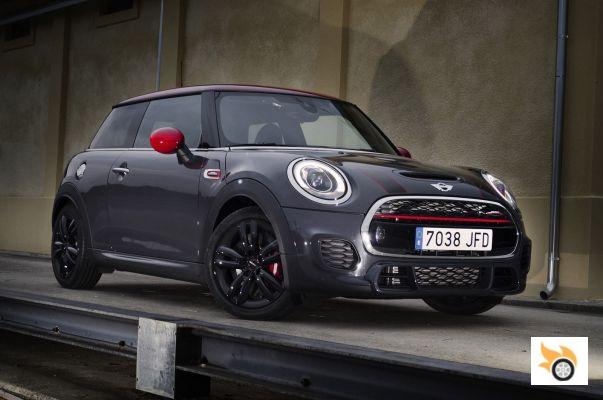
I'll admit that I'm not an absolute fan of the current "new" MINI. With the passing of the generations, and we have already commented on several occasions, as in the Cooper S test, the car has lost the keys that caused the success of Frank Stephenson's design (now at McLaren) with which the brand was resurrected at the dawn of the XXI century.
That MINI R53 (in its Cooper S and JCW version) combined super-short overhangs, an expensive to manufacture, sculpted hood with integrated optics, and a very well achieved wheel-wheelbase-height-length proportions.
The problem for the company has been that it has been losing that set of proportions progressively. From the R53 to the R56 the waistline was raised, the bonnet got fatter and lost shapes and details and the lateral proportions lost their initial essence. It was a consequence, they said, of the new pedestrian protection regulations in case of being run over, which forced to change the front of the car. But it was also to reduce the production costs of the bodywork.
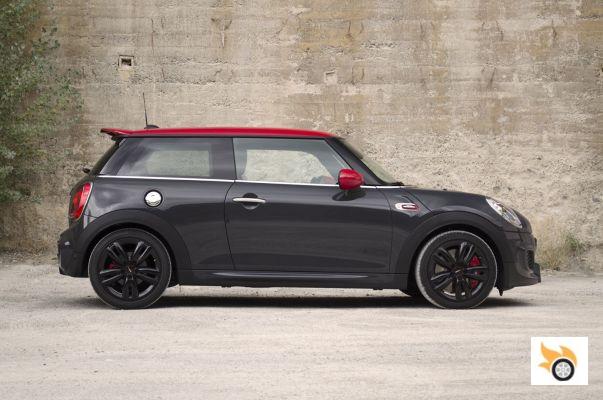
From the R56 to the current F56 the leap has been even bigger. The front overhang has had to grow, a lot. This has been sought by not having to fatten the hood more, to pass with honors the standards of protection to run over and embrace the new UKL1 platform of BMW, which has already given rise to this MINI and the 2 Series Active Tourer, and which will still leave many more offspring, in the form of the 1 Series, Countryman, Clubman and company.
Certainly, as the months have gone by, we've grown accustomed to the MINI's new look, and it works better for us now. In fact, I think it's better proportioned in its ratios than the F56, but it's no prettier than the F56. In this JCW trim it looks its best, thanks to an aggressive body kit that includes a prominent front air intake under the main grille and two asymmetrical side air intakes, the one on the left being "real" to feed what appears to be the oil radiator (the intercooler looks front facing), while the right intake is blind.
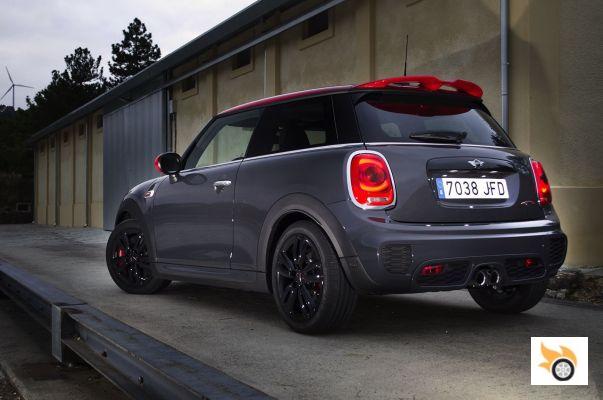
The side is dominated by wheels which, on the test unit, were optional 17″ ones. As standard it wears another design, with forged rim, but undoubtedly, the ones that look the best are the 18″ and five arms that emulate the design of those used in the last GP. The plastic side wings gain a lip to cover as the law dictates the track width in top view. Although it doesn't look like it because of the fall of the wheels and the curve of the bodywork, the rims are at the limit of width.
The red Brembo brake calipers on the front rims are striking (they are rigid, alloy and have four pistons). At the rear, the huge lights are still... huge. There's a cooler central twin exhaust than the Cooper S, while the tailgate adds a three-dimensional spoiler that's better integrated than on previous JCWs.
The air vents that accompany the bumper are all fake and make us wonder if the designers here haven't overdone it all. But in the same way, the front bonnet also has a fake air intake on top of it. All in all, I'm not crazy about it anymore, not even in JCW trim, something that the first MINI of the new era managed to do.
Cabin
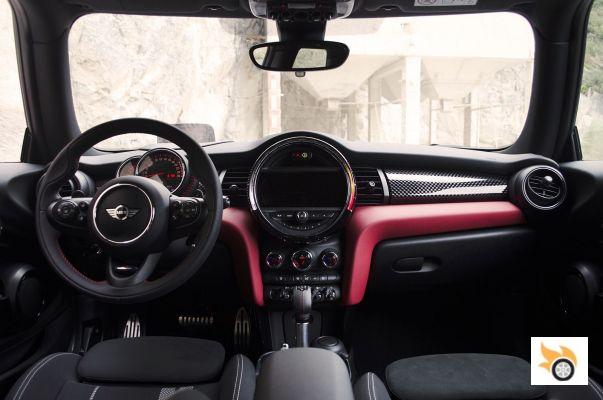
But what doesn't convince me on the outside, changes radically in the cabin. And it's not that the first MINI was "bland", but here the evolution has been positive. I'm one of those who misses that the central clock has been lost, although for practical reasons you'll never look at the speed on it, but it was an original and cool decorative element.
Be that as it may, the interior has taken another big leap forward over the F56. In the JCW we tested, the red strip integrated in the lower part, together with the beautiful steering wheel and the "racing" touches in the form of "chequered flag" integrated in several places make up a diametrically opposed driving place to what you find in a BMW. And if the Bayerische is "Germanic", with interiors that are always the same, bland but practical, in the F56 everything is a feast of design. I understand that some people might not like it, but the reality is that for me it's a breath of fresh air. A place to sit and feel special. There's no other B-segment that matches the MINI in this respect, and even its real market rivals (typical JCW customers aren't looking at a B-segment, but an Audi TT) don't play this game either.
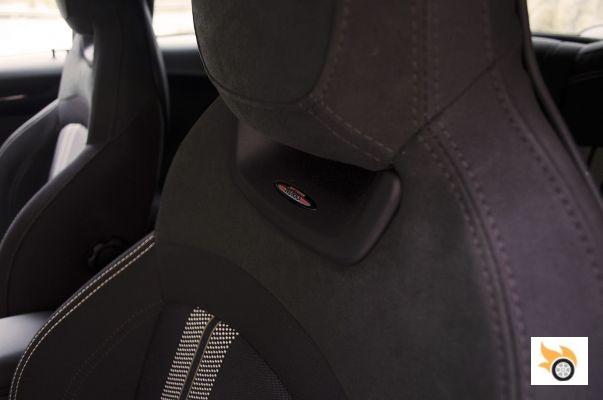
What used to be a problem in the previous two generations, ergonomics, has gradually ceased to be. Now all the controls are where you'd expect them to be. The driving position is simply perfect. The sports seats grip your body perfectly, and even though you're a hair taller than in the R53 and R56, you're still a hair shorter in absolute terms. You can put the steering wheel just where you want it, and sit in a position that, without leaving BMW, is somewhat reminiscent of a Z4 for "stretched legs". The pedal unit is another delight, with the throttle rocking on the floor, and the infotainment system combines tactile and physical controls, so you can interact with it as you prefer.
The downside? The same as before. Although the MINI has grown a lot since the R53, it's still a two-plus-two. The rear seats are impossible for adults. To give you an idea: with the driver's seat in my position (1.73m tall), I'd have trouble spending time in the back seats myself. And there's an even more odious comparison: A Fiat 500, much shorter than this car, has much more room and more livable space in the rear bench.
Why is that? Because of the driving position. The more upright you sit in a car, the more room it leaves for more people to fit in the same wheelbase. Cars like the 500 require a very upright driving position, which can feel a bit awkward at first. In the MINI, the car is designed for the driver (and front passenger), which allows to take care of those seats with plenty of space and a driving position enviable even by some sports cars, but the toll is that the back can not ride adults. Even accommodating children will be difficult, because of the limited space to handle child seats back there.
The boot is no party either. 211 litres are enough for a few parties. It's clear that two people can go shopping or go on holiday with it, but putting baby carriages or other large and complicated objects in it is out of the MINI's reach. So yes, on the outside it has grown, but inside it's still the equivalent of a coupe with a two-plus-two trunk. Again, the Audi TT springs to mind. And no, it's no coincidence.
Technical
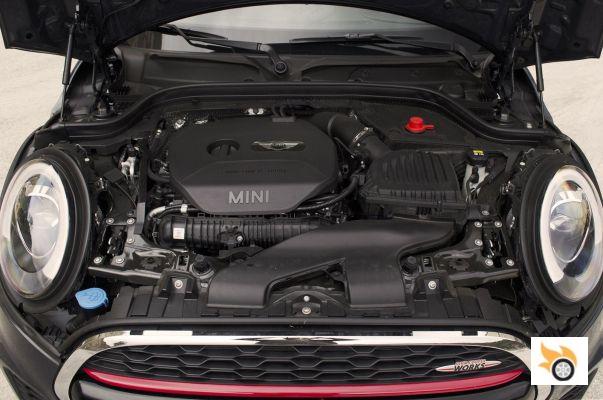
The best and worst of the new MINI comes from the use of the new UKL1 platform. The worst goes to the fact that there was "minimal size" and "minimal overhangs" that have killed the opportunity for a shorter overhang aesthetic and different proportions, but the trade-offs are huge.
BMW needed to make money with MINI, but at the same time had to remain competitive in the market. The brand's livelihood depended on having a front-wheel drive platform that would allow it to build enough cars in total to pay for itself, while integrating the best possible technology into it.
With no option to share a platform with other rivals (nobody in the B-segment wants to mess with cars with multi-link rear suspension), BMW has created the UKL1, a compact front-wheel drive platform with a range of engines "100% BMW", equipped to the top of technology. And MINI has benefited.
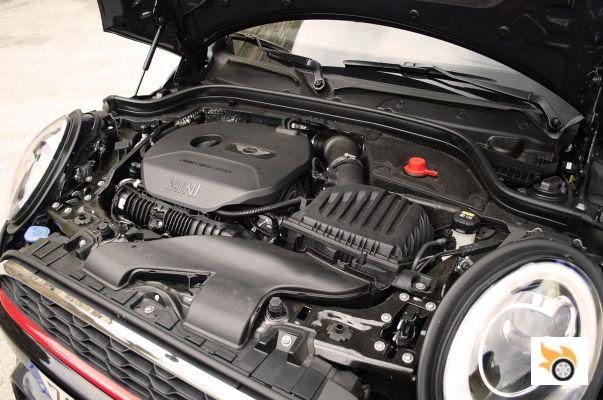
The new generation of the car uses a shortened compact platform (hence the generous wheelbase and front overhang, as well as the wide track). It's gained a lot of technology, but for the JCW what interests us most is that it's gained a four-cylinder, two-litre, twin-scroll turbocharged, direct-injection petrol engine, with variable valve timing, which is on the cutting edge of everything BMW knows how to do with engines.
And since BMW is one of the best engine companies on the planet, the results are noticeable. It's an engine with a peak torque of 320 Nm that's available from just 1,250 rpm, which is just past idle. It's capable of delivering 231 hp at 6,000 rpm, and still stretching a hair further before the cut-off. In other words, there's a 4,750-rpm engine range. A beast. Homologates an average consumption of 5.7 liters per 100 kilometers, which is another impressive data.
The engine can be paired with a six-speed manual gearbox or a torque converter automatic with the same number of ratios, which has two large paddle shifters behind the steering wheel to operate it. Obviously, if you're looking for cornering fun, I understand that you'll prefer the manual gearbox, but the first batch of units produced by MINI of this new JCW were with automatic transmission, so virtually all press units seen throughout Europe are automatic, including the one we had for a week.
In terms of chassis, the JCW uses a monocoque that is already rigid in itself, with intensive use of very high-strength steel, and with the advantage that, thanks to this, the weight is contained. The car is bigger than before, but not considerably heavier. BMW explained that, had it not been possible to share the platform with other models of the firm, the MINI could not have used so much "good" steel.
The front suspension is McPherson struts while the rear is a multi-link, which is still unique to it in the B-segment it "supposedly" belongs in (more on that in the conclusions). The use of an independent rear suspension not only serves to better control wheel contact with the road in hard cornering, but it is also better at preventing unwanted wheel movement under high lateral loads. By independently controlling longitudinal and transverse forces, the tyre footprint remains uniform, without "dancing" at load changes, resulting in better steering feel and precision, while being able to better filter the state of the pavement.
The suspension uses "hard" coil springs, and matching shock absorbers that can be passive or variable as an option, using magnetorheological technology (a magnet changes the density of the liquid inside the shock absorbers, making them more restrictive in their movements). All the bearings and joints are specific to the JCW, being stiffer than on the Cooper S, seeking to improve the precision of the line and the ability to transmit to the driver what the car does on the asphalt.
On the attack
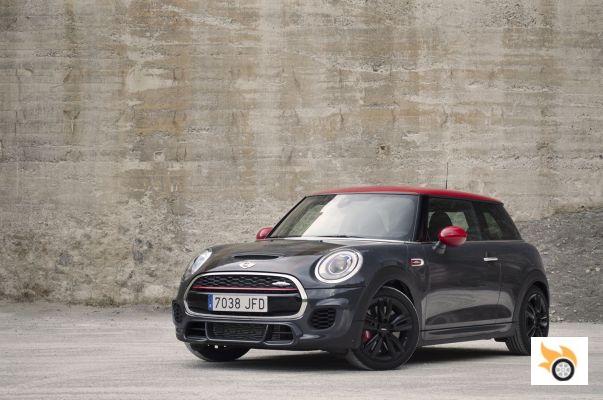
But now it's time to put all this technology to the test. As soon as you touch the start button, the JCW makes its intentions clear with a lovely exhaust purr. There's no need to look for electronic engine sound synthesis. Through the menus and sub-menus you can end up finding the oil and coolant temperature, so you can wait for everything to get up to temperature before putting the screws to the JCW. In the meantime, as I headed off to my favourite combination of roads for testing, I had time to notice curious details. For example, the instrument cluster behind the steering wheel is not well thought out for a sports car. The speedometer takes center stage, leaving the lap counter too much to the side, which is difficult to consult. The Head Up Display already supports the speed display, but unlike BMW's "eme", there's no place for the engine revs.
On the gear lever you have in a concentric ring the driving mode selector, which goes from an eco mode to a normal one and then to a sporty one. The nice thing, and necessary, as we'll see later, is that you can set what the "sport" mode affects... I selected sport mode, and touched the traction control button. The first touch causes the ESP to go into a permissive mode. The front end has electronic emulation of the self-locking differential, and it becomes more aggressive in this mode.
And so, with the car already warmed up and ready for action, my "port attack" began. Pedal to the floor and the first surprise came from the engine. Well, to tell the truth, in the Cooper S the engine had already pleased me, but in this iteration, the two-liter seems powerful and endless. There's no lag. You accelerate and it responds like a very full naturally aspirated engine, with splendid acceleration ability and great metering via the right pedal.
The automatic gearbox followed my upshift commands without any problems. It's clear that a manual gearbox is more interactive, but at this stage of the film, the sensations were positive with the torque converter in manual mode, pulling its paddles.
The first section of the road has a "sponsored by the European Union" asphalt, smooth and in very good condition, so the suspension enjoyed it. And so I reached the first serious corner. Foot on the brake. The feel of the pedal is overshadowed by the fact of being an automatic car, where there is usually some sponginess in the first millimeters of travel before "getting hard" and start to be able to dose. At least it's not over-assisted, and the powerful Brembo's are dosable.
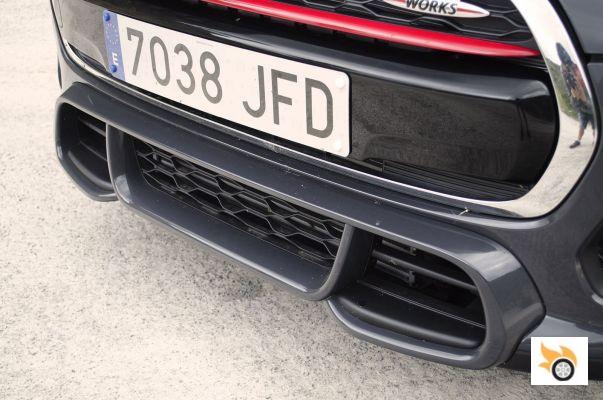
The steering is almost telepathic. As soon as I thought about the apex of the corner and looked towards it, the JCW went for it with 20 degrees of steering wheel turn. The car turns flat. The nose is itching to get into the corner, and the steering is ultra-fast. Driving a JCW is as "special" steering-wise as an Alfa Romeo or a Ferrari, in that you can take almost any corner of any port without having to let go of the rim to turn the steering wheel more than 90 degrees. It's something that takes some getting used to, as the first couple of corners will probably throw you in too far. But the brain recalibrates quickly.
In exchange for the quick steering, there's hardly any feedback. Talking to a Ferrari engineer some time ago, he told me that with such direct steering, if you put more information through the rim, it would be difficult to handle, as the corrections and vibrations have to be extremely precise, and any vibration or change in the steering wheel load could create instabilities in the steering wheel rim that would prevent you from taking advantage of the steering precision.
And the JCW has plenty of that. Wherever you want to go, the car goes telepathically. You can drive over that little pebble in the gravel that you've just spotted with the sidewall of the tyre. It's this whole first set of sensations in the first few corners that immediately brings a smile to your face. I took advantage of the power of the engine in those moments to shoot out of each corner looking for the next one on the horizon.
But the asphalt started to curl.
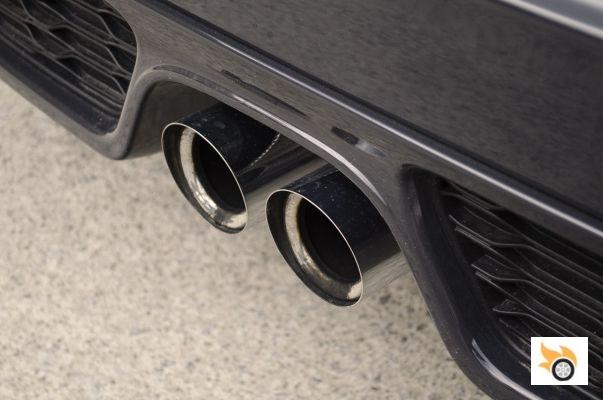
The test area I'm using usually freezes in winter, and then gets scorched in the sun, which creates quite nice wrinkles in the asphalt, which are the perfect measuring system for the suspension performance, and also to serve the first scare with the MINI. In the middle of a very fast right-hand corner, there's a noticeable group of four curls. The suspension, with its sporty damping settings, immediately proved incapable of dealing with this.
The first pass caused a tremendous bounce that required quick reflexes to catch the car and stabilize it. Four more bumps in support served to prove that with the damping in its most restrictive mode, it doesn't let the springs work. Yes, the car is straight and true and doesn't pitch, but it doesn't swallow the bumps. So I stopped on a hard shoulder and went into the on-board computer menus. There I was able to remove the sport damping from the Sport mode, to continue on the road with the shock absorbers in "comfort" mode.
And what a change. The MINI's suspension with this platform represents an epic leap from past generations. There's no more little travel. Now there's a competent suspension that, with the dampers in place, swallows bumps in support without the car "jumping" wildly.
The MINI is still a car that feels "low", where your butt is "close to the road", and where you feel the wheels on the edges as you turn flat and sit right in the center of the car's pivot when it starts to yaw to turn. It's that so-called "go-kart feel", which is also complemented by the ability to yaw the rear if required.
With such direct steering, you have to be wary of playing too hard with throttle loads, but the F56 JCW is more mature than ever, and doesn't bite as much as it used to. It still allows you to close lines, aided by both the rear and the self-blocking emulation, but it adds more dimensions to the traditional MINI. If before it was old school, brave, fun and addictive, now it's still fun, but it's also more capable, flows better through corners and doesn't choke on potholes.
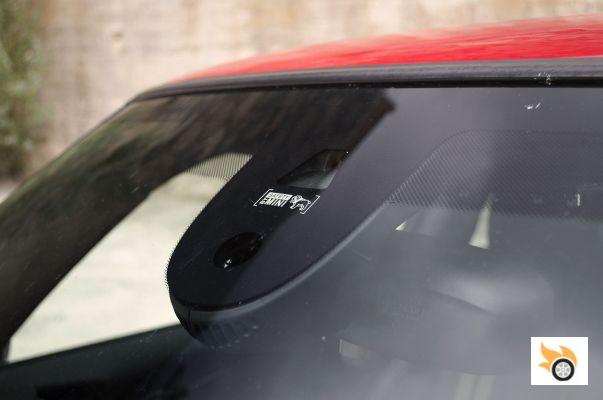
It doesn't matter if the road is more twisty or bumpy. The only downside is that the car has grown and attacking corners with it now requires almost thinking you're driving a compact, as you don't feel the car is as small as the R53. But the overall feeling is that of a very capable car, with a couple or three very specific drawbacks.
At a fun pace, the first thing to fall out of the equation is the tyres. In the Cooper S we were already complaining bitterly about the choice of a too-stiff, too-stiff Pirelli P7 Cinturato. The problem is that in this JCW, with 231 horsepower, those same tires are still there in section 205. These are tires that wear little and are run-flat, but that conditions the lateral grip and also the ability of the car to "talk to you". The fact that the casing barely flexes and that the loss of grip comes sooner than expected means that you don't feel the road as much as you'd like. And mind you, the JCW, while the steering doesn't talk to you much, it does let you feel through the seat how it's feeling on the tarmac.
The chassis proves far more capable than the tyres say it is. I'm convinced that this chassis will be able to digest 300 horsepower when it arrives, and that it would be much better with sporty tyres, be it PZero or better still, Pilot Sport or Potenza. These Cinturato, if I bought this car, would be the first thing I would take off.
Then there's the gearbox. While it's comfortable in town and effective at 80% of the car's potential, it struggles when downshifting. You can play with it, yes, and if you leave the left hand paddle pressed down while braking at the mouth of the corner, it will engage the lowest possible gear so that you're thrown out of the corner afterwards, but the fact that it doesn't have a manual gearbox takes away a dimension of driving fun. I'd take this car in manual, hands down.
And then there's the brakes, as a final gripe. While the Brembo brakes were powerful and metered, the brake pedal feel could be improved. I'd like to test this car in manual variant to make sure if it improves, which I imagine it will. But then there is the resistance to fadding. For the second time in a row with a powerful car, I had another brake fade going down one of the three chained passes I usually do. It's a demanding pass for the brakes, as it has second gear bends joined by very fast sections, which makes you stop the car a lot. But it seems that each and every one of the cars we tested with self-locking emulation in that descent ends up eating the brakes, starting to leave the pedal lower than desired. The solution will be in a self-locking or in emulation systems that know when not to overdo it with the brakes so as not to reduce the efficiency of the system. Either that, or I'll have to start loosening up my braking.
Conclusions
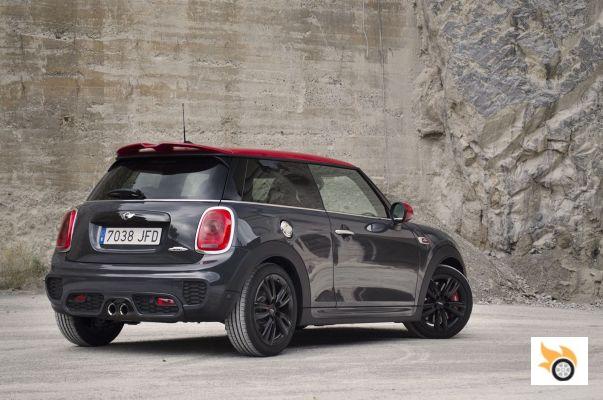
With the automatic transmission, the JCW goes for 33,700, but the manual can be bought for £31,750. At this point in the film, after reading the whole thing, you might think it's stupid to spend the money on a JCW when you can buy a Fiesta ST, which is "the king of the sport utility vehicles", for much less. But the JCW doesn't play in that league.
While the MINI may look like a B-segment SUV, this John Cooper Works, with its 231 horsepower, competes in a different league. The target customers for this product, and MINI knows this well, are buyers of the Audi TT 230 hp (£41,150) and Volkswagen Golf GTI 220 hp (around £32,000). These are customers who don't lose any sleep over the price tag. They are looking for a car with iconic status, with design, with power and that can be equipped with a lot of equipment.
Against those rivals, the JCW has a lot to say. It's more fun to drive than a TT, and with the right tyres, it'll outperform the Golf GTI too. In fact, with 80-120 in 4.1 seconds, 0-60 in 6.1 seconds and a top speed of 246 per hour, it's as quick as the 230bhp TT or the aforementioned Golf GTI (it beats the Golf, in fact). Inside it has tons of extra styling over the Germans, and while the Golf has more rear seats and a useful boot, many of the potential customers, as the TT demonstrates, pass on that in the back or boot space. I will say that I also find the JCW a more addictive car.
But "the best is yet to come". BMW has still held a lot of cards with this car. There will be GP variant, we know, and this time it will come before the end of the car's life. The two-litre engine can deliver close to 300 horsepower without breaking a sweat, by sharpening up its delivery a bit and boosting it a bit. The chassis can handle that extra power, it will be enough to fit some decent tyres and a real locking system (an active one would be the best, and it can't be ruled out, as it's likely to be developed for the future M135i). With just those two tweaks, the future GP could become the best front-wheel drive sports car on the market, and will probably make its rivals sweat at the Nürburgring. Because it has all the elements to match the times of the wildest beasts in the C-segment.
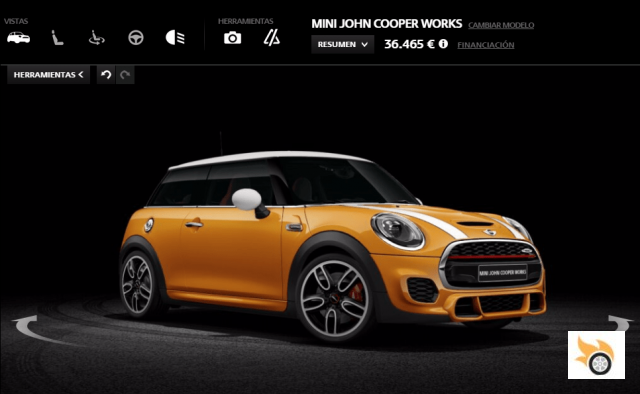
Would I buy it? As always, or almost always, we've taken a dig at another test car. But yes, I like this JCW. Aesthetically the MINI is no longer at its best, but I like the cabin, the driving position too, the engine is one of the best, if not the best, four-cylinder in the world, and with four tweaks that can be achieved in house (self-blocking and tyres), it would become a fearsome tool. I'd like to have it in yellow-orange with white stripes and roof and last generation GP wheels (yes, the one in the picture above). Although if I was going to have an "almost two-seater", I'd almost think about buying a JCW GP R56.

























